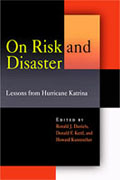As the Gulf Coast attempts to recover from the emotional and physical scars of Hurricane Katrina, the nation’s most expensive natural disaster, Wharton and University of Pennsylvania faculty are raising questions about how society should assess and perceive risk, and how it should compensate victims when disaster strikes.
Analyzing the Role of the U.S. Government as Insurer of Last Resort when Disaster Strikes
A new book entitled, On Risk and Disaster: Lessons from Hurricane Katrina, by University of Pennsylvania provost Ronald J. Daniels, political science professor Donald F. Kettl and Howard C. Kunreuther, Wharton professor of operations and information management, argues that the U.S. government has become an insurer of last resort and questions whether that unofficial policy is contributing to larger and costlier disasters.
Preparing for Future Threats After Hurricane Katrina
The hurricane, which last summer killed 1,300 and wiped out more than 250,000 homes, is only one example of the kind of calamity that confronts the United States, the book points out. Earthquakes, tornados, pandemic disease and terrorism are also threats.
The book grew out of a symposium on the Katrina disaster sponsored by the University of Pennsylvania in Washington, D.C., in December. A second symposium is scheduled for February in Philadelphia. “Our hope is that the dialogue on the broader social and political issues of government’s responsibility to, and its relationship with, its citizens in situations of risk and disaster will be advanced and will lead to new policy outcomes that will mitigate the impact of future disasters on the lives of fellow Americans,” says Daniels.
The Challenge of Assessing and Managing Risk Before and After Disaster Strikes
The central themes of the book are the importance of assessing the risk associated with a disaster in advance and, equally important, gauging how the risk is perceived and how people will react to the risk. In addition, says Kunreuther, the book explores how to manage risk before and after a disaster, stressing the links between the two.
Redevelopment in New Orleans Post-Katrina: Rebuilding the Levees
Meanwhile, policy proposals to deal with the devastation in New Orleans continue to emerge. A blueprint for redevelopment under discussion by New Orleans city officials would allow residents to return and rebuild anywhere in the city, even in heavily damaged areas and those that are vulnerable in the future.
The Complexities of Rebuilding and Economic Recovery
At the same time, Rep. Richard H. Baker, a Republican from Baton Rouge, is pushing legislation to create the Louisiana Recovery Corp., which would spend up to $80 billion to pay off real estate lenders and homeowners. The corporation would sell bonds to pay property owners up to 60% of the equity in their real estate before the storm and clean up large tracts of the city. The corporation would eventually sell the land back to developers. The idea is similar to the Resolution Trust Corp. created by Congress to bail out the savings and loan industry in 1989.
Balancing Cost and Infrastructure Security
“The challenge really is to ask, ‘At what price do you rebuild New Orleans?” asks Kunreuther. “And how do you accomplish this in such a way that low-income people and those who can’t afford to take protection can be assisted?” One has to make a choice, he adds. “Do you help people in advance of disaster and make an area safer — which may require subsidies to low-income people from the government or other sources — or do you wait until after a disaster occurs and then provide large amounts of disaster assistance?”
Kunreuther, who is also co-director of Wharton’s Risk Management and Decision Processes Center, says the key to devising strategies for disaster is to accurately assess the odds of one occurring, but also to consider how people will react to the risk. “Perception of the risk is a really challenging issue,” he says. “People always say, ‘This is not going to happen to me,’ until after a disaster occurs.”
Prudent policy, he adds, calls for risk assessment in advance of disaster that includes a detailed cost-benefit analysis of the price of preventive measures versus the value of property. An evaluation of issues of fairness and equity, particularly as it relates to low-income residents is also important, Kunreuther notes.
Still, perception of risk remains a critical piece of the formula. “You can look at issues of efficiency and equity, but unless we really understand how people are treating that risk and perceiving it, we are not going to make good policies,” says Kunreuther. “It’s that combination of the assessment and the perception which led us to ask what the right strategies are.”
Levee Construction and the Illusion of Safety
He uses the example of building a new levee to protect against floods. “If a levee is built, everyone says, ‘I’m now protected by that levee.’ As a result, there may be greater development than there otherwise would have been. If that levee is topped, the damage could be far worse had the levee not been built. That doesn’t mean that the levee should not be built, but doing that alone without assessing the risk and the perception of the risk misses the dynamics of the whole process.”
Addressing the Vulnerability of Levees Post-Katrina
A poor assessment of risk limits the possibility of mitigating future problems, particularly as decisions are being made about rebuilding in the aftermath of a disaster like Katrina, according to the authors. “As the first private insurance dollars and public relief checks started to flow, everyone discovered a new problem,” the book states. “Especially in New Orleans, it was impossible to begin recovering from the last catastrophe without preparing for the next. The levees have remained vulnerable to even modest storms, and everyone wants to know: Will new levees be built? What kind of storm could they withstand? Might we pour tens of billions of dollars into the city only to risk having it wiped out again?”
Learning from the Governmental Failures that Led to Katrina’s Damage
The overlying political system adds to the problems of dealing with natural disasters as Katrina revealed, says Kettl, the political science professor. “A large part of what happened with Katrina was both the failure to plan adequately in advance, but more importantly the failure of the different governments — local, state and national — to work effectively together as a team in providing a response,” he says. Kettl points out that as thousands were without food and water in the Superdome, the federal government had food stored in nearby warehouses and helicopters on the ground. “The connection was just not made.”
Part of the problem, he adds, is that many government jurisdictions were drawn up more than 200 years ago when it was important to be a day’s travel — by horseback — from the county seat, according to Kettl. “That made a lot of sense in the 1700s and 1800s, but it’s not a good match for a disaster on the scale of Katrina, or the terror and public health problems we confront today.”
Creating a new set of governmental boundaries would not help either, he says. Instead, what is needed is seamless coordination between governments, as well as the private sector and individuals. For example, Coast Guard Vice Adm. Thad Allen, who was appointed to replace former Federal Emergency Management Agency director Michael Brown as the head of disaster coordination for Katrina, demonstrated the ability to work well with other agencies in the weeks following the hurricane. “His instincts are all toward coordination and spanning the boundaries,” says Kettl. “We know how to do it, we just don’t do it often enough.”
“Moral Hazards” and the Role of Federal Aid
Another political issue that came to light in the Katrina disaster is the disconnect between federal and local interests. While the disaster’s impact was local, the federal government has pledged the resources of the entire country to aiding those in the region hit hard by Katrina. This leads to what economists call the “moral hazard” problem, in which individuals face no real consequence of their decision to rebuild or to go without insurance because they know the federal government will step in after a crisis to bail them out.
While it is not an official policy, Kettl says the examples of other hurricanes, including Andrew in 1992, and the September 11, 2001 terror attacks, suggest the federal government is politically unable to turn its back on victims of disaster.
For example, the book notes, local officials have little incentive to steer development from particularly hazardous areas or enforce tough building codes if it is not they, or their citizens, who pay the price to rebuild. “When the federal government comes in and writes a check, you will keep doing things over and over because even though it is not a formal policy, it is how people have formed their expectations,” says Kettl.
If the federal government plans to continue to pay out after natural disasters, it should come out and say so and adjust other aspects of the legal and regulatory system, he says. For example, it could require flood insurance in vulnerable areas to protect the interests of taxpayers who don’t live anywhere near an area that is prone to disaster.
“As it is now, everybody just winks and knows the government will come,” says Kettl. “What happens with policies that you back into like that is they almost always end up costing more in disruption and money in the long run than something we would have thought through in advance.”
Coordinating Risk Management Between the Public and Private Sectors
As for future strategies, Kunreuther stresses the need for improved coordination between the public and private sectors. For example, he says, homeowners might be reluctant to invest in flood prevention measures because they don’t want to spend money to prevent a problem that they believe is not likely to occur.
Even a reduction in insurance premiums would not convince most homeowners to pay up front to solve a potential problem. Instead, one creative solution would be to tie investments in property that would lessen the damage from a natural disaster into mortgages, says Kunreuther. For example, homeowners might be reluctant to pay upfront for a $2,000 investment that could protect their home, even if it reduced insurance premiums by $300 or $400 a year. But if it were folded into a 30-year mortgage, homeowners would find that the reduction in their insurance premium, if rates are based on risk, would be greater than the extra cost of their mortgage payments. “Everyone is a winner. The homeowner would have lower total monthly payments for their mortgage and insurance, the insurers would have a lower chance of suffering catastrophic losses, banks would have a safer investment and the general taxpayer would have less to pay for disaster assistance to aid victims.”
Like a repair that could prevent future damage, the authors are hoping their book can help governments and residents plan better to reduce the impact of a natural disaster. “Katrina revealed a large gap between the capacity of our policies and institutions and our needs, as individuals and as a society,” they write. “We need a fresh understanding of the problems, and new and creative solutions to tackle them. That is the most important lesson of Katrina and if we fail to learn it Katrina’s legacy will not be ‘bigger and better.’ It will be ‘bigger and worse.'”


